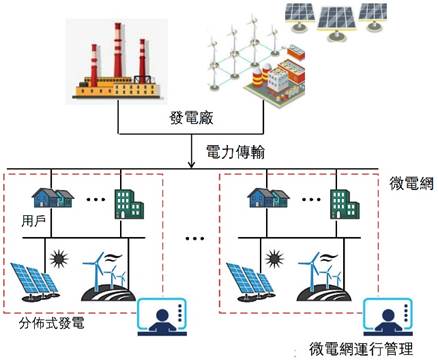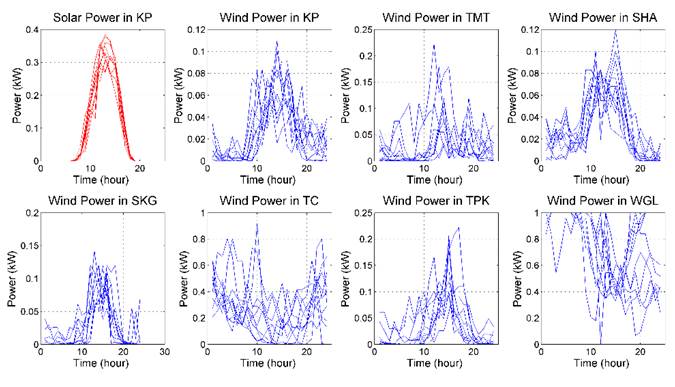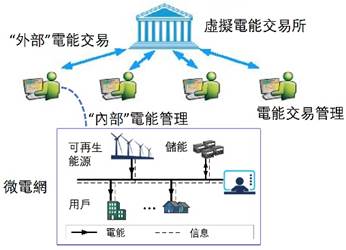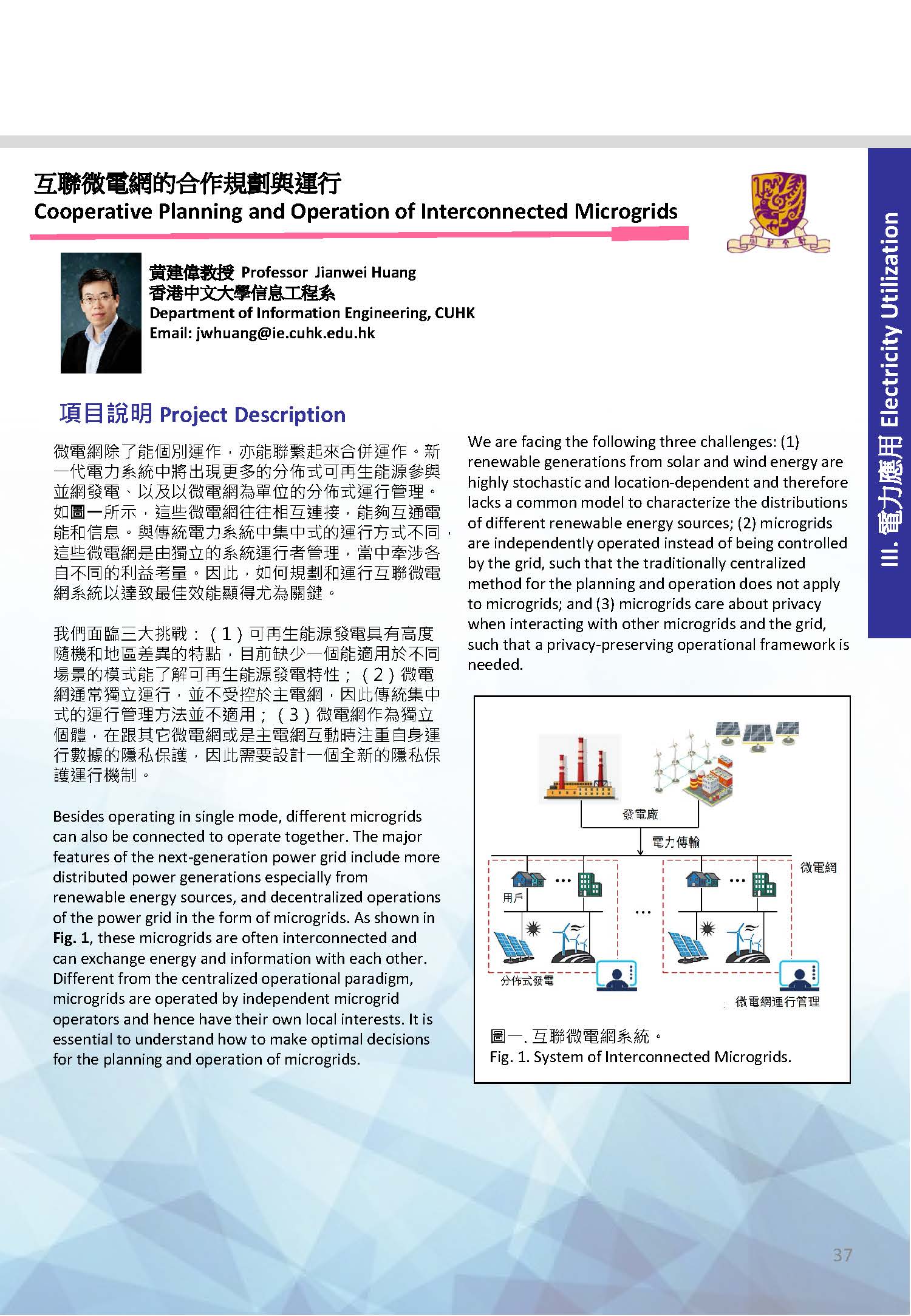Subtopic 5: Microgrid Monitoring, Management, and Comprehensive Security
互聯微電網的合作規劃與運行
Cooperative Planning and Operation of Interconnected Microgrids
項目說明Project Description
微電網除了能個別運作,亦能聯繫起來合併運作。新一代電力系統中將出現更多的分佈式可再生能源參與並網發電、以及以微電網為單位的分佈式運行管理。如圖一所示,這些微電網往往相互連接,能夠互通電能和信息。與傳統電力系統中集中式的運行方式不同,這些微電網是由獨立的系統運行者管理,當中牽涉各自不同的利益考量。因此,如何規劃和運行互聯微電網系統以達致最佳效能顯得尤為關鍵。
我們面臨三大挑戰:(1)可再生能源發電具有高度隨機和地區差異的特點,目前缺少一個能適用於不同場景的模式能了解可再生能源發電特性;(2)微電網通常獨立運行,並不受控於主電網,因此傳統集中式的運行管理方法並不適用;(3)微電網作為獨立個體,在跟其它微電網或是主電網互動時注重自身運行數據的隱私保護,因此需要設計一個全新的隱私保護運行機制。
Besides operating in single mode, different microgrids can also be connected to operate together. The major features of the next-generation power grid include more distributed power generations especially from renewable energy sources, and decentralized operations of the power grid in the form of microgrids. As shown in Fig. 1, these microgrids are often interconnected and can exchange energy and information with each other. Different from the centralized operational paradigm, microgrids are operated by independent microgrid operators and hence have their own local interests. It is essential to understand how to make optimal decisions for the planning and operation of microgrids.
We are facing the following three challenges: (1) renewable generations from solar and wind energy are highly stochastic and location-dependent and therefore lacks a common model to characterize the distributions of different renewable energy sources; (2) microgrids are independently operated instead of being controlled by the grid, such that the traditionally centralized method for the planning and operation does not apply to microgrids; and (3) microgrids care about privacy when interacting with other microgrids and the grid, such that a privacy-preserving operational framework is needed.

圖一. 互聯微電網系統。
Fig. 1. System of Interconnected Microgrids.
可再生能源發電的多樣性 Diversity of Renewable Energy Generation
為了解決第(1)個挑戰,我們開發了一套以數據主導的多地點可再生能源發電分佈模型。如圖二所示,使用真實氣象數據,我們創建了香港七個地點包括太陽能和風能在內的可再生能源發電場景。從圖中可以看到,不同地區的可再生能源發電呈現明顯的多樣化特徵,數據有力地証明了由於這種多樣性,有系統地管理及規劃它們將帶來可觀的經濟效益。
To address the first challenge, we developed a data-driven method to model the distributions of renewable energy generations over multiple locations. We used meteorological data to calculate the solar and wind generation scenarios of seven locations in Hong Kong shown in Fig.2. The results show diverse profiles of renewable energy generations in terms of technologies and locations, validating the potential economic benefit of cooperative planning of renewable energy generations.

圖二. 可再生能源發電場景,包括如下地點:京士柏 (KP)、大尾篤(TMT) 、沙田(SHA) 、西貢(SKG) 、大老山(TC) 、大埔滘(TPK) 和横瀾島(WGL)。
Fig. 2. Scenarios of renewable energy generations in locations: King’s Park (KP), Tai Mei Tuk (TMT), Sha Tin (SHA), Sai Kung (SKG), Tate’s Cairn (TC), Tai Po Kau (TPK), and Waglan Island (WGL).
合作規劃方案的成效及數據安全 Performance of Cooperation Planning and Data Security
為了開展互聯微電網的合作,同時解決挑戰(2)和(3),我們提出了一套對於獨立運行微電網系統的合作規劃和合作運行方案。具體來說,基於「納什議價理論」,我們設計了一個公平成本攤分方法,以鼓勵微電網的合作規劃從而令社會成本減至最低。結果表明,合作規劃方案能能夠節省投資成本達35.9%。針對微電網的合作運行,我們進一步提出了促進互聯微電網能源交易的分佈式算法,如圖三所示。每一個微電網負責優化自身的電能交易和經濟調度,並只需要提交外部電能交易決定,由虛擬交易所負責結算微電網之間的交易從而保護微電網運行中的數據隱私。我們為互聯微電網系統提出了一個理論框架,以協調可再生能源發電的配置和調度。我們的交易算法也為分佈式電源在配電網中的市場設計提供了依據。
To enable such a cooperation among microgrids and address the second and third challenges, we developed cooperative frameworks for the planning and operation of interconnected and self-interested microgrids. Specifically, we designed a fair cost-sharing scheme to split up total investment cost using the “Nash bargaining solution”, which incentivizes proactive participation of microgrids toward socially optimal planning of renewable generation. Such a cooperative planning method can save the total investment cost by 35.9%. We further designed a distributed energy trading algorithm shown in Fig. 3. Our algorithm can protect the privacy of microgrids in a way that each microgrid optimizes its energy trading and scheduling by itself and only reports external trading bids to a virtual energy clearinghouse for the settlement. The trading algorithm sheds light on the design of transactive energy markets for distributed energy resources over power distribution networks.

圖三. 微電網電能交易算法(其中, 微電網負責優化自身的發電調度和需求響應,並只需提交電能交易決定)。
Fig. 3. Energy trading algorithm for interconnected microgrids (in which, microgrids optimizes its internal power scheduling and only reports external energy trading).
相關文獻 Related Paper:
- Hao Wang & Jianwei Huang. (2018). Incentivizing energy trading for interconnected microgrids. IEEE Transactions on Smart Grid, 9(4): 2647 - 2657. [Link]
- Hao Wang* & Jianwei Huang*. (2016). Cooperative planning of renewable generations for interconnected microgrids. IEEE Transactions on Smart Grid, 7(5): 2486 - 96. [Link]
Copyright © 2014 Faculty of Engineering, The Chinese University of Hong Kong. All rights reserved.

